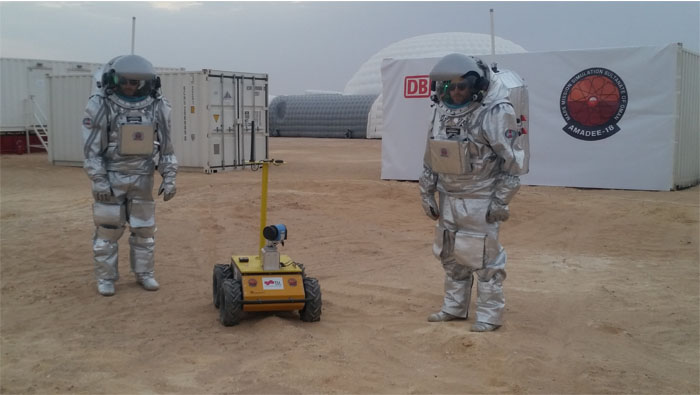
Marmul: The first space suit to be used by a manned mission to Mars is being tested in Oman.
The Austrian Space Forum (Oestereichiches Weltraum Forum or OeWF) is currently testing a prototype of its spacesuit that will one day be worn by astronauts who touch down on the Red Planet.
The tests are a part of the AMADEE-18 Mars simulation mission, which is being conducted near the town of Marmul, some 250km from the Dhofari capital of Salalah, in the middle of the country’s southern desert.
Christened Aouda, after the Indian princess that Phileas Fogg falls in love with in Jules Verne’s “Around the World in Eighty Days”, the spacesuit has been in development over the last seven years and is the only one currently being designed by a European body.
Aouda contains latest technological and scientific tools on board, including a device that monitors fatigue, stress, and tension levels, long-range communication devices that enable the astronauts to communicate with Earth, a five-hour battery and life-support system, as well as an in-helmet heads-up display to help astronauts take vital readings on Mars.
Simulation astronauts
Four simulation astronauts, Joao Lousada, Stefan Dobrovolny, Inigo Munoz and Carmen Kohler, will test the suit in Oman. Wearing the suit does take some getting used to as it weighs nearly 55kg, and that’s without the additional vital equipment it will carry on Mars.
“The chest piece of the suit is made from the same material that is used to make Kevlar armour,” Dobrovolny said, speaking exclusively to the Times of Oman, which had been invited to spend a few days at the base camp in Marmul.
“When we began to look at ways to design the suit, we actually went to museums in Austria to look at medieval armour to see how well they protected people, because that was the inspiration for our suit,” he added.
“The suit may weigh some 55kg right now but it will become a lot heavier when we go to Mars, because it will carry oxygen bottles and other vital equipment. “Fortunately, the gravitational pull on Mars is only some one-third of that on Earth, so we have planned the tests in such a way that we face the same weight on Mars, as we will on Earth. Before we go to Mars, though, we will need to conduct a full simulation of the suit, possibly at our headquarters in Innsbruck,” Dobrovolny further remarked.
Two Aouda suits have currently been designed: Codenamed Sierra and X-Ray. The two suits have been designed to operate independently, but they also contain support systems for each other to function, in cases of emergency.
“The batteries of the suit have been designed to last for some five or six hours, but in case one is low on battery, we have a cable that can be used to connect one suit to the other so that charge from one battery can be transferred to the other,” Michael Muller, who is part of the suit operation crew at the OeWF, said.
“The ring around which the helmet fits has been made from a vanadium alloy,” Florian Voggeneder, a pit crew member for the OeWF, said. “This material is so hard that standard industrial drills cannot penetrate it and there are only, maybe, three companies in Austria that work with these sort of metals. We decided to use this because the Martian surface is unpredictable and we don’t know how often our astronauts may fall down, so we need the ring to be intact all the time,” he added.
Sensitive equipment
“Despite it having a lot of protection on the inside, we have to treat this suit very carefully because it has a lot of sensitive equipment. The outer material is also made from a special fabric that does not allow any microbes that we would have carried from Earth escape into the Martian atmosphere, and doesn’t allow the Martian air to enter our suits as well,” he said.
The suit, though, is only part of a bigger exploratory set-up: an exoskeleton has to be worn with the Aouda to ensure stability and greater safety on the Martian surface.
Inigo Munoz, another analogue astronaut for AMADEE-18, said: “We are currently working on moving around with just the suit for now, but soon, we will have tests with the exoskeleton as well. This will take some getting used to because it is quite heavy and you need to have stamina to do this for long periods of time. On Mars, we will not have regular access to food or water, so we have to really condition ourselves to this.”
“We are also constantly giving feedback on both the exoskeleton and the suits to the manufacturers so they can take it into consideration and improve both of them for future tests, ahead of our mission to Mars,” he added.